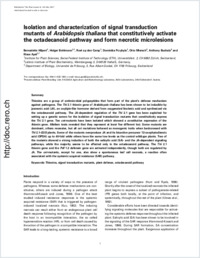Isolation and characterization of signal transduction mutants of Arabidopsis thaliana that constitutively activate the octadecanoid pathway and form necrotic microlesions
- Hilpert, Bernadette Institute for Plant Sciences, Swiss Federal Institute of Technology (ETH), Zürich, Switzerland
- Bohlmann, Holger Institute for Plant Sciences, Swiss Federal Institute of Technology (ETH), Zürich, Switzerland
- Camp, Roel op den Institute for Plant Sciences, Swiss Federal Institute of Technology (ETH), Zürich, Switzerland - Plant Breeding Unit, FAO/IAEA Agriculture and Biotechnology Laboratory, Seibersdorf, Austria
- Przybyla, Dominika Institute for Plant Sciences, Swiss Federal Institute of Technology (ETH), Zürich, Switzerland
- Miersch, Otto Leibniz Institute of Plant Biochemistry, Halle, Germany
- Buchala, Antony J. Department of Biology, Université de Fribourg, Switzerland
- Apel, Klaus Institute for Plant Sciences, Swiss Federal Institute of Technology (ETH), Zürich, Switzerland
-
2001
Published in:
- The Plant Journal. - 2001, vol. 26, no. 4, p. 435-446
English
Thionins are a group of antimicrobial polypeptides that form part of the plant's defense mechanism against pathogens. The Thi 2.1 thionin gene of Arabidopsis thaliana has been shown to be inducible by jasmonic acid (JA), an oxylipin-like hormone derived from oxygenated linolenic acid and synthesized via the octadecanoid pathway. The JA-dependent regulation of the Thi 2.1 gene has been exploited for setting up a genetic screen for the isolation of signal transduction mutants that constitutively express the Thi 2.1 gene. Ten cet-mutants have been isolated which showed a constitutive expression of the thionin gene. Allelism tests revealed that they represent at least five different loci. Some mutants are dominant, others recessive, but all cet mutations behaved as monogenic traits when backcrossed with Thi 2.1-GUS plants. Some of the mutants overproduce JA and its bioactive precursor 12-oxophytodienoic acid (OPDA) up to 40-fold while others have the same low levels as the control wildtype plants. Two of the mutants showed a strong induction of both the salicylic acid (SA)- and the JA-dependent signaling pathways, while the majority seems to be affected only in the octadecanoid pathway. The Thi 2.1 thionin gene and the Pdf 1.2 defensin gene are activated independently, though both are regulated by JA. The cet-mutants, except for one, also show a spontaneous leaf cell necrosis, a reaction often associated with the systemic acquired resistance (SAR) pathway.
- Faculty
- Faculté des sciences et de médecine
- Department
- Département de Biologie
- Language
-
- English
- Classification
- Biological sciences
- License
-
License undefined
- Identifiers
-
- RERO DOC 5511
- DOI 10.1046/j.1365-313X.2001.2641036.x
- Persistent URL
- https://folia.unifr.ch/unifr/documents/299991
Statistics
Document views: 133
File downloads:
- Texte intégral: 231
